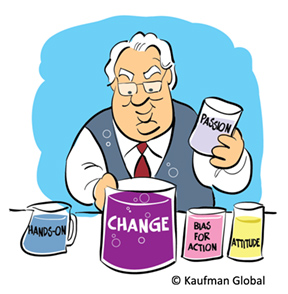A Committed Leader: The Key Ingredient for Change
In my role as a management consultant at Kaufman Global, I work within a variety of industries ― both the public and private sectors ― assisting clients with driving sustainable change across their enterprise. In partnership, we work to reduce costs, improve the quality of their products and services, and identify new opportunities within their markets ― all while increasing productivity. During these engagements, I am always asked the same question, “What is the biggest contributing factor to a successful Lean implementation or cultural transformation?” My answer is always the same: A committed leader.

“The task of leadership is not to put greatness into people, but to elicit it, for the greatness is there already.” — John Buchan, Scottish politician, author (1875-1940)
The term “leadership” can be defined in a lot of different ways, but essentially leadership occurs from one’s ability to guide, direct, or influence people. Within any culture change, Leadership’s role is to create a vision that their employees can believe in, and ultimately foster their desire to achieve it. In other words, human beings want someone who inspires them to be the best they can be.
The most successful leaders I’ve worked with are committed to bringing out the best in all employees. They understand the very essence of their organizations and regularly stimulate hope amongst their teams for brighter futures. They do so by exhibiting the following qualities:
A Willingness to “Get Their Hands Dirty”
Leaders need to spend time out of their offices. They need to work alongside their staff to appease their anxieties and solicit their input for improvements. Taking these ideas and transferring them across the company is the key. By listening to these ideas, a leader can establish relationships based on confidence and trust. He or she becomes a trusted advisor, demonstrating that continuous improvement is not only desired but adopted by leadership.
A Passion for Making a Difference
Strong leaders have a continual desire (passion) for making a difference in peoples’ lives by consistently enabling and empowering them to be successful. Many employees don’t care until they see that their leadership does. When implementing a Lean culture, resistance to change is often present early on, but people don’t mind being asked to do something different if they see that the leader truly cares about their future. In fact, when a committed leader makes decisions, he or she does so with the organization’s success in mind. People want to be inspired to achieve their best and become what they know they can be.
A Good Attitude
Leadership is about attitude. Leadership is about walking the walk. It is much easier to demonstrate the vision than to explain it in words. People watch a leader’s feet more than they listen to their words. A strong leader inspires hope, develops trust, earns respect, and provides encouragement ― all by treating others with respect and conveying a positive attitude.
Recently, I had the pleasure of working with a top leader that exhibited all of these qualities, resulting in one of the best client engagements that I have ever been a part of. After being newly hired, this leader came in and observed the existing work environment and the interaction of his senior leadership. Instantly, he recognized that the team was too large to be effective. There was little accountability, and decisions were rarely ― if ever ― made during meetings. As a result, he quickly reconfigured the team and set very clear expectations of how the team would perform moving forward. Just weeks later, he came to the realization that the right people were not sitting at the leadership table, as one of this leader’s key strengths was ― and still is ― recognizing others who possess leadership qualities and promoting them accordingly. He understood that getting the right people, in the right place, at the right time was critical.
To cut to the chase, the way this leader bridged the gap that existed between management and staff looked rather effortless. He drove changes by making himself available, listening to employees, showing respect to customers and staff, creating a bias for action, not being satisfied with the status quo, and inspiring the masses. In the end, others were willing to learn because he demonstrated how important it was to change. He walked the walk, maintained a positive attitude and demonstrated the organization’s vision repeatedly. Through his valiant efforts, I watched as the organization soared to new heights.
At the end of the day, a committed leader bets on his people being able to achieve their goals. He or she ensures that the right people are in place and removes any barriers in their way. In fact, at the start of the journey, getting the right people in the right jobs is a lot more important than developing a strategy. The best leaders are not those that develop more followers, but those that develop more leaders.
**********
Learn more about how best to nurture Lean leadership, read our Developing Operational Excellence Leaders White Paper.
Some simple behaviors leaders can do to build better relationships at work (and everywhere): Your People First – 5 Relationship Expectations
“The task of leadership is not to put greatness into people, but to elicit it, for the greatness is there already.” — John Buchan, Scottish politician, author (1875-1940)


